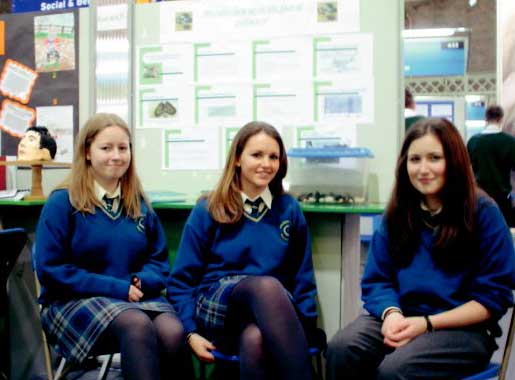| 2004 |

|
YEAR BOOK |
Glanmire Community College, Glanmire, Co. Cork
|
Mussels clam up in the face of pollution
|

Firstly we collected mussels from our chosen sites: clean site, Ringaskiddy; polluted site, Douglas Estuary. We dissected mussels from both sites and removed the gill, mantle and digestive gland, for protein determination and analysis.
Before we could analyse our samples it was necessary to homogenise the samples in a buffer solution and spin them in a centrifuge. The reason for centrifugation was to separate the protein in our samples that we would need for further testing. When spun at high speeds, the cellular parts of the organs (cell membrane etc.) were separated from the protein in the organs. The cellular parts formed a pellet at the bottom of the centrifuge tube and the protein was in liquid form, called the supernatant. The supernatant was then extracted.
Next, we made up a protein standard (BSA) and we tested the absorbencies of the BSA spectrophotometrically. We were then able to generate a protein standard curve, which we used to evaluate the average protein absorbencies of the different supernatants, against the equation for a straight line: Y = MX+C.
We ran an electrophoresis gel to see the effect of pollution on certain types of proteins: GST and HSP40. Both are proteins produced in response to stress and are responsible for detoxification. We could see that they were present more abundantly in the polluted site than in the clean site in the digestive gland of the mussels because of the higher levels of stress they were under. (Being filter feeders, mussels ingest waterborne contaminants when they filter the food they need from water and concentrate the contaminants in their tissues, particularly in the digestive gland).
In conclusion we have proven that mussels are very good indicators of environmental pollution; and we also had a great time at the Young Scientist Exhibition.
Sharon Looney, Karen Cotter & Emily Keenan entered their project in the Senior Group Section in the Biological and Ecological Sciences Category at the EsatBT Young Scientist & Technology Exhibition in January 2004. They won a Special Award sponsored by the Marine Institute. Their teacher was Mr Brendan Walsh.
|
|
| This article was sponsored by the Marine Institute |
|---|